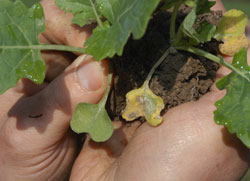
Downy Mildew is running rife in oilseed rape crops with the unseasonably warm and continued wet weather. Although cotyledons are frequently attacked with little serious damage to plants, this year new leaf growth is also heavily infected and could result in significant leaf loss of important true leaves.
The Syngenta Technical Enquiries Helpline has received calls from worried growers and agronomists from the southern counties up to the Wash over recent days, seeking a solution to unprecedented levels of disease, reports the company's Fungicides Technical Manager, Beth Hall. "With infection rapidly moving up the plant it is important to protect new leaves," she advises.
"Options are very limited, but an application of Bravo at the first signs of infection on the cotyledons or lower leaves will provide long lasting protection of clean leaves." Bravo (chlorothalonil) can be tank mixed with Phoma applications, such as Plover. "But with the high level of Phoma infection this year, if they have already gone on, a separate Downy Mildew application could be justified," she believes; "Waiting for the second Phoma application may be too late."
Mrs Hall adds that with day length shortening and light levels falling, small crops in particular need to be kept growing to get well established before winter. "Protecting the first and second true leaves from being lost to Downy Mildew could maintain an important extra 25% of photosynthetic green leaf area."
Syngenta trials have shown early cotyledon loss in establishing crops can lead to a lack of plant vigour and a serious check in development, with significant differences between infected and uninfected plants, particularly in later sown crops. Autumn disease infection is also likely to lead to earlier build up of secondary Downy Mildew infection in the spring, particularly in thick crops.
